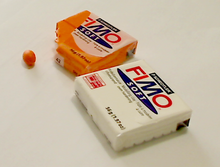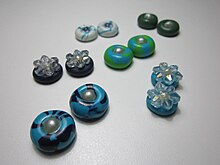Polymer clay
FIMO is the brand and sales name of a modeling clay that is manufactured by STAEDTLER Mars GmbH & Co. KG and before that up to and including 2009 by Eberhard Faber GmbH, which it has owned since 1978. According to the manufacturer, the main ingredients are PVC and phthalate-free plasticizers .
use
The modeling clay was and is offered in a wide range of colors. As a typical representative in the field of modeling compounds, FIMO also has the property of being easy to shape. As is typical for the product group, FIMO can be cured in the standard version in the oven or under other heat sources at 110 ° C. In addition, STAEDTLER offers the FIMOair product line as an alternative - a modeling compound that hardens in the air and at room temperature. According to the manufacturer-specific instructions for use, the FIMO modeling clay has the following characteristics: “In its raw state, it can be processed in many ways (mixed or covered with liquid paints or powders, stamped, textured and much more). But even after hardening, you can still z. B. stamped, carved, turned, drilled, ground and polished, with z. B. acrylic paints or varnished with colored or clear varnish. One can u from her. a. Manufacture figures, dolls, miniatures, decorative items and jewelry. "
According to the manufacturer's age recommendations, FIMO is suitable for children aged eight and over. Curing by means of a heat source should be done under adult supervision.
history
The basic recipe for FIMO was invented in 1939 by Sophie Kruse, a daughter of Käthe Kruse . Originally, a new material for the production of dolls' heads was to be developed, but this project was not successful in this direction. After experimenting with various other additives came as a new product instead in 1954 a modeling for the end user under the name Fimoik on the market, composed of the nicknames of the inventor Fi fi , Mo delliermasse and Mosa ik .
In 1964 the rights were sold to Eberhard Faber, who changed the name to FIMO in 1966.
In 1978 Staedtler took over the Faber company and with it all rights regarding FIMO. FIMO sales units have been produced directly with the Staedtler logo since 2010.
Use and health risks
If FIMO is swallowed contrary to its intended use, stomach acid hardens it and can cause internal injuries due to sharp-edged formation. Consult a doctor if swallowed.
According to the manufacturer's recommendation, the prescribed temperature of 130 ° C must not be exceeded, even when used properly, as otherwise more harmful hydrochloric acid vapors may arise. Accordingly, it is also recommended to keep your distance during the curing process, to continuously ventilate the area and not to exceed the temperature and time limits.
toxicity
FIMO complies with the EU Toy Directive and the corresponding EN standard EN71 Part 5 , which defines the requirements for the substances and materials used in chemical toys - with the exception of experiment kits. As a result, FIMO is entitled to bear the CE mark , which corresponds to the clearance certificate for placing on the market throughout the EU. FIMO falls under the standardization according to EN71 Part 5, as this product is a "plasticizer-containing modeling clay set to be hardened in the oven".
In the United States , FIMO is checked every five years by the Duke University Medical Center and has so far been allowed to bear the AP non-toxic seal of ACMI (Arts and Crafts Material Institute) based on the safety certificates issued in the USA .
Despite the formal approvals that legitimize the marketing of the product, the following should be noted in the course of the general debate on the health risks of heated plastics and plasticizers:
- In 1993 the magazine Ökotest examined and tested various permanent and non-permanent hardening modeling compounds - including FIMO. Of 21 modeling putties examined, FIMO belongs to the group of three permanently hardening modeling putties, all of which were classified as not recommended . These modeling compounds have an additional warning from the manufacturer: Not a children's toy (since then the phthalate-containing plasticizers that have been banned in children's toys in the EU have been replaced by others). As is typical of the product, the other modeling compounds tested did not harden permanently.
- The EU is investigating whether the component PVC poses any health risks .
A possible health risk is possibly increased by the heating used during curing and the associated increased volatility of the substance per unit of time.
You should therefore not eat, drink or smoke at the place of use. After use, hands that have come into contact with the product and all working materials should be washed with soap and water. Furthermore, only tools recommended by the manufacturer in the instructions for use should be used.
Trivia
In the GDR , a comparable product was manufactured and sold under the name SURALIN.
Web links
Individual evidence
- ↑ a.staedtlercdn.com ( Memento of the original from March 21, 2014 in the Internet Archive ) Info: The archive link was inserted automatically and has not yet been checked. Please check the original and archive link according to the instructions and then remove this notice. (PDF)
- ↑ acminet.org ( Memento of the original from May 12, 2008 in the Internet Archive ) Info: The archive link was automatically inserted and not yet checked. Please check the original and archive link according to the instructions and then remove this notice. (PDF)
- ^ Environmental problems of PVC (Green Paper of the EU Commission) accessed on June 18, 2012

